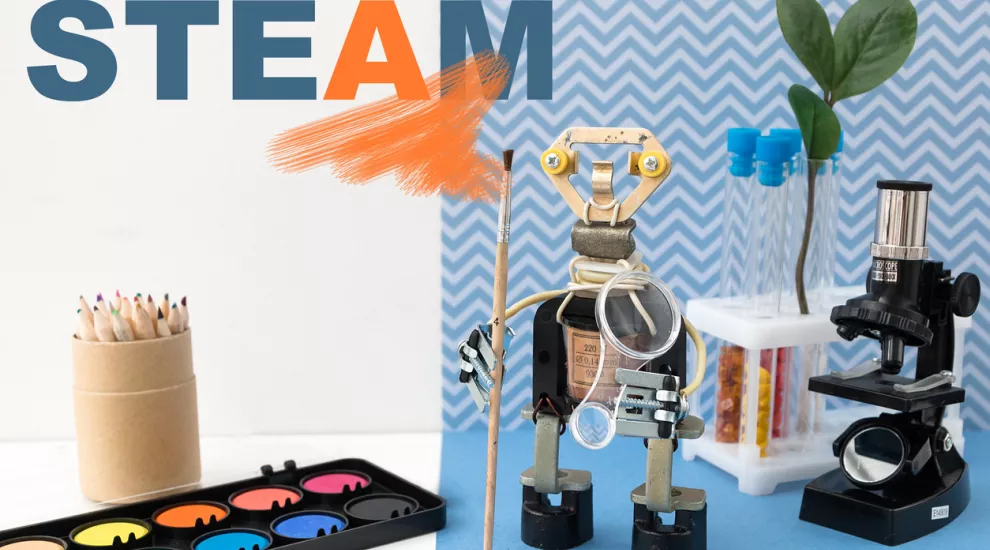
From our Educator Guest Blogger Series
What is STEAM?
STEM...STEAM...STREAM...HAMSTER education has recently received a big push around the world. Each letter in the acronyms stands for a different subject:
- S - Science
- T - Technology
- E - Engineering
- A - Art
- M - Mathematics
Reading (R) and the Humanities (H) are not included as often in literature or discussion so we will leave them out for the purpose of this post. Also, it does not matter the subjects listed in the acronym because the main idea is that students are engaged in authentic, integrated learning experiences. Students are taking part in the 4 C’s for 21st Century Learning - collaboration, communication, critical thinking, and creativity. The goal is to prepare students for a future in college and careers, some of which does not exist yet. STEAM education is meeting the needs of the South Carolina graduate.
More than an Engineering Challenge
Before I began learning about STEAM education, I had heard about it and seen it start popping up on sites like Pinterest and Teachers Pay Teachers. A search for “STEAM” on any search engine or social media will return quick engineering challenges, literacy-based challenges, problem-based challenges, technology integrated lessons, and makerspace resources. These sites have a wealth of knowledge, information, and resources; however, they don’t cover the whole picture. For the longest time, I assumed (and I still fall into this pitfall) that STEAM meant that students were building and engineering something. Looking beyond a spaghetti and marshmallow challenge is essential. STEAM education is this and so much more!
STEAM education needs to make connections between subjects and topics to break down the silos of learning. It should encourage teachers to look past blocking the day into subjects of learning and instead look at learning periods. STEAM doesn’t have a checklist and can’t be bought in a curriculum, but there are some aspects that you might find at different moments in quality STEAM education.
- 4 C’s of 21st Century Learning - Collaboration, Communication, Critical Thinking, and Creativity are considered necessary skills for our students to be successful in the 21st-century world. These are not included in any specific order, and individual schools and organizations might even include a 5th C like coding, caring, citizenship, or character education.
- Collaboration - working together to reach a goal
- Communication - understanding and communicating ideas
- Critical Thinking - looking at problems in new ways
- Creativity - innovative and imaginative new solutions
- Integrated - The integration of STEAM subjects together can link student learning and add relevance. STEAM integration should be intentional and specific. Total integration is not always necessary as the goal is not to diminish the importance that the content areas can hold on their own. Sometimes subjects can be given equal weight, and other times some are allotted more weight. Integration can be of the content, context, or the needed background. See Advancing Elementary and Middle School STEM Education.
- Student-centered - When education is built around the students’ interests, passions, and abilities teachers will find much more success than trying to model the students to fit the teaching practices. Teachers can allow students to guide the questions, the process, and/or the conversation.
- Authentic - When school work is authentic it provides a relevant purpose for the learning. Teachers can create authentic learning experiences by bringing in real-world problems in the local community or providing an authentic audience for student work and ideas.
- Career Connections - STEAM education is a great tool to prepare children for their futures in college and careers. However, students cannot be what they cannot see. We must make intentional connections between our class content and the jobs of today and the future.
STEAM in Action: The Global Goals
This year in my classroom I began looking at The Global Goals established by the United Nations to reach by the year 2030. They are also called the Sustainable Development Goals or SDGs. There are 17 of them that focus on global issues from quality education to life on land. Students chose a goal that they felt was the most important to research, create a presentation, and design a project around. Through this project, I was able to embed many of my content standards while focusing on student interest in real-world issues.
Helpful Resources
While STEAM education can’t be bought in a box and a complete lesson or unit can’t be found online, there are a lot of great resources online to meet your standards and the needs of your students. Remember that you are the educator and curator of your students’ education...be STEAM-azing!
- The World’s Largest Lesson - Collection of resources and information to help bring the Global Goals to children all over the world through education, projects, and action
- PBS KIDS: The Cat in the Hat Knows a Lot About That - Games, videos, and printed resources. Most activities promote a science, engineering, and/or design theme with a focus on critical thinking and creativity. Option to switch the language to Spanish.
- PBS KIDS: Design Squad Global - Hands-on activities and resources for real-world problems to understand the impact of engineering
- South Carolina PBS LearningMedia - Learning resources for teachers and students. Sort resources for teacher use by standard (when logged in), grade level, topic, and much more. Set up a class and assign resources to students.
- Teach Engineering - Searchable database of standards-based activities, lessons, units, and challenges for K-12 educators
- STEAM Career and Content Connections - Hosts videos of professionals sharing their career experiences for each of the STEAM content areas. From Kansas State University’s College of Education
Bio
Megan McNinch is Technology Teacher and STEAM enthusiast at Sugar Creek Elementary in Fort Mill, SC. She teaches students to be responsible digital citizens; to navigate the world wide web; to create, edit, and collaborate on projects; to program computers; to create, make, and innovate; to connect globally. She is proud to be the Sugar Creek Teacher of the Year, serve on the Discovery Education STEAM Teacher Leader Corps, coach several amazing VEX IQ robotics teams, and present at state and regional conferences. She is a Google Level 1 Certified Educator, PBS Digital Innovator, Common Sense Education Ambassador, and Freckle Ambassador. She holds a bachelor’s degree in elementary education from the University of North Carolina at Chapel Hill, a master’s degree in special education from Western Governor’s University, and is currently pursuing a doctoral degree in curriculum and instruction and license in school administration from Liberty University. You can follow her on Twitter at @McNinchie.
Note: This guest blog does not necessarily reflect the views of ETV Education.
